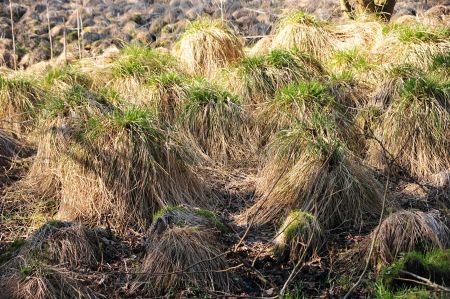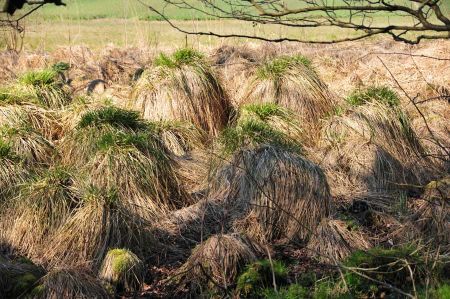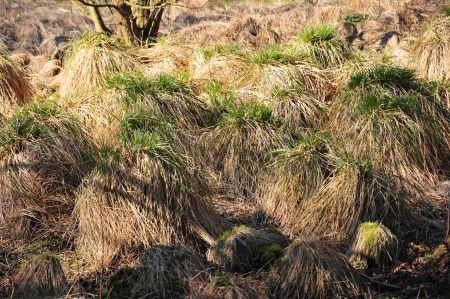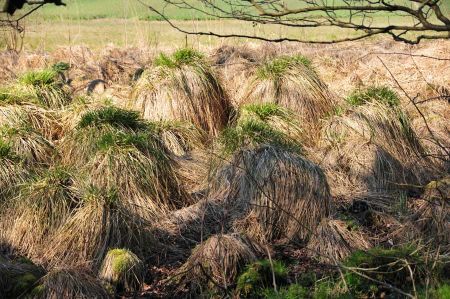Rigid sedge - this swamp plant contributes to silting up
- Written by Portal Editor
Our hike along the Lossa creek not only gave us deep insights into the meadow landscape with its typical small plants on and in the water, along with the alder, birch and willow trees on the shore.
Beautiful floodplain landscapes, which unfortunately are still being drained in order to gain cultivation or settlement areas for people. How nice when you come across a natural, at least apparently intact meadow landscape every now and then. So our thoughts went when roaming the riparian region.
Two relatively flat meadows to the right and left of the creek then indicated pasture farming, but further ahead with dense thatched stock by the stream: clearly marshland. A large depression was clearly visible, the vegetation also changed. Always interesting when it becomes so clearly visible after only a few meters. In the valley we saw tufts of grass that seemed to grow out of the swamp at an odd height. Our interest was already piqued again.
Bulten - plant growth of a special kind
 Sure, the living conditions in the swamp area are different, so the growth of the plants is also different. If it is just possible to settle grasses in certain places, no wonder that the shoots of a plant are very close to each other. In botany, such a form of plant growth is referred to as eyrie. Such clumps of shoots are created by growing out the bottom axillary buds without forming runners. The side shoots are usually upright. The formation of such clumps is characteristic of many sweet and sour grasses on special soils. Large clumps that grow over time are called Bulten. These Bulten we saw over here, which already had reached a considerable height.
Sure, the living conditions in the swamp area are different, so the growth of the plants is also different. If it is just possible to settle grasses in certain places, no wonder that the shoots of a plant are very close to each other. In botany, such a form of plant growth is referred to as eyrie. Such clumps of shoots are created by growing out the bottom axillary buds without forming runners. The side shoots are usually upright. The formation of such clumps is characteristic of many sweet and sour grasses on special soils. Large clumps that grow over time are called Bulten. These Bulten we saw over here, which already had reached a considerable height.
Rigid sedge - a swamp plant that tends to grow Bulten
 The stiff sedge is widespread throughout Europe, with the exception of the extreme north and up to Central Asia, from the plains to middle mountain ranges. It is rare in Central Europe due to the few natural wetlands left, but mostly it occurs in large numbers at its sites. In the mountains you will only find the Rigid Sedge up to about 1,500 meters, in the Allgäu Alps it only occurs up to 1200 meters above sea level.
The stiff sedge is widespread throughout Europe, with the exception of the extreme north and up to Central Asia, from the plains to middle mountain ranges. It is rare in Central Europe due to the few natural wetlands left, but mostly it occurs in large numbers at its sites. In the mountains you will only find the Rigid Sedge up to about 1,500 meters, in the Allgäu Alps it only occurs up to 1200 meters above sea level.
The stiff sedge grows in wet meadows, bogs, in the silting-up areas of stagnant and slowly flowing waters on waterlogged, nutrient and base-rich clay and silt soils. The plant avoids cold water. It often forms mass stocks that essentially consist of this one species only, the so-called Steifseggenriede (Caricetum elatae). In silt-up zones of lakes and slow-flowing waters, this type of sedge often stands out due to its stately, tiered clusters (bulte or bulte). It populates water depths of up to 0.5 m with individual specimens and then becomes dominant inland. As a deep root, it contributes to the silting up of water.
 The stiff sedge is just one of the typical marsh plants in the silt zone, a so-called helophyte with a sharp leaf margin, which serves as protection against animal damage. So not really anything special, but due to the height, almost like a trunk, then again becomes special.
The stiff sedge is just one of the typical marsh plants in the silt zone, a so-called helophyte with a sharp leaf margin, which serves as protection against animal damage. So not really anything special, but due to the height, almost like a trunk, then again becomes special.
Please read as well:
Meadow landscape - a walk along the Lossa
Wood anemone - white flower in the green carpet
